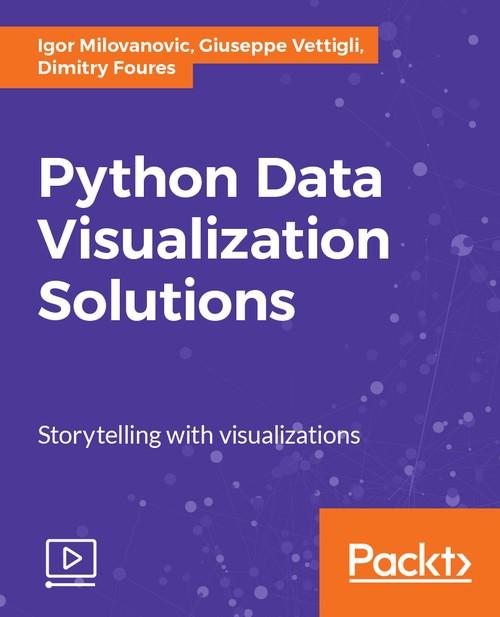Oreilly - Python Data Visualization Solutions
by Dimitry Foures, Giuseppe Vettigli, Igor Milovanović | Released November 2016 | ISBN: 9781787122802
Create attractive visualizations using Python's most popular libraries About This VideoSet up an optimal Python environment for data visualizationImport, organize, and visualize your data with the popular open source Python libraries such as matplotlib, NumPy, plot.ly and moreA practical tutorial to help you determine different approaches to data visualization, and how to choose the most appropriate one for your needsIn DetailEffective visualization can help you get better insights from your data, and help you make better and more informed business decisions.This video starts by showing you how to set up matplotlib and other Python libraries that are required for most parts of the course, before moving on to discuss various widely used diagrams and charts such as Gantt Charts. As you will go through the course, you will get to know about various 3D diagrams and animations. As maps are irreplaceable to display geo-spatial data, this course will show you how to build them. In the last section, we'll take you on a thorough walkthrough of incorporating matplotlib into various environments and how to create Gantt charts using Python.With practical, precise, and reproducible videos, you will get a better understanding of the data visualization concepts, how to apply them, and how you can overcome any challenge while implementing them. Show and hide more
- Chapter 1 : Knowing Your Data
- The Course Overview 00:03:38
- Importing Data from CSV 00:04:33
- Importing Data from Microsoft Excel Files 00:04:46
- Importing Data from Fix-Width Files 00:03:06
- Importing Data from Tab Delimited Files 00:02:23
- Importing Data from a JSON Resource 00:05:17
- Importing Data from a Database 00:05:09
- Cleaning Up Data from Outliers 00:05:54
- Importing Image Data into NumPy Arrays 00:06:01
- Generating Controlled Random Datasets 00:06:36
- Smoothing Noise in Real-World Data 00:04:45
- Chapter 2 : Drawing Your First Plots and Customizing Them
- Defining Plot Types and Drawing Sine and Cosine Plots 00:07:53
- Defining Axis Lengths and Limits 00:05:16
- Defining Plot Line Styles, Properties, and Format Strings 00:01:59
- Setting Ticks, Labels, and Grids 00:02:43
- Adding Legends and Annotations 00:02:33
- Moving Spines to Center 00:01:22
- Making Histograms 00:03:59
- Making Bar Charts with Error Bars 00:03:23
- Making Pie Charts Count 00:01:59
- Plotting with Filled Areas 00:01:56
- Drawing Scatter Plots with Colored Markers 00:02:13
- Chapter 3 : More Plots and Customizations
- Adding a Shadow to the Chart Line 00:03:56
- Adding a Data Table to the Figure 00:02:26
- Using Subplots 00:03:57
- Customizing Grids 00:03:05
- Creating Contour Plots 00:03:24
- Filling an Under-Plot Area 00:02:01
- Drawing Polar Plots 00:02:56
- Visualizing the filesystem Tree Using a Polar Bar 00:03:03
- Chapter 4 : Making 3D Visualizations
- Creating 3D Bars 00:05:33
- Creating 3D Histograms 00:03:13
- Animating with OpenGL 00:06:02
- Chapter 5 : Plotting Charts with Images and Maps
- Plotting with Images 00:06:18
- Displaying Images with Other Plots in the Figure 00:03:52
- Plotting Data on a Map Using Basemap 00:05:23
- Generating CAPTCHA 00:06:36
- Chapter 6 : Using Right Plots to Understand Data
- Understanding Logarithmic Plots 00:05:19
- Creating a Stem Plot 00:04:18
- Drawing Streamlines of Vector Flow 00:03:28
- Using Colormaps 00:05:17
- Using Scatter Plots and Histograms 00:04:29
- Plotting the Cross Correlation Between Two Variables 00:03:27
- The Importance of Autocorrelation 00:04:11
- Chapter 7 : More on matplotlib Gems
- Drawing Barbs 00:06:24
- Making a Box-and-Whisker Plot 00:03:37
- Making Gantt Charts 00:03:50
- Making Error Bars 00:04:40
- Making Use of Text and Font Properties 00:04:00
- Understanding the Difference between pyplot and OO API 00:05:13
Show and hide more





